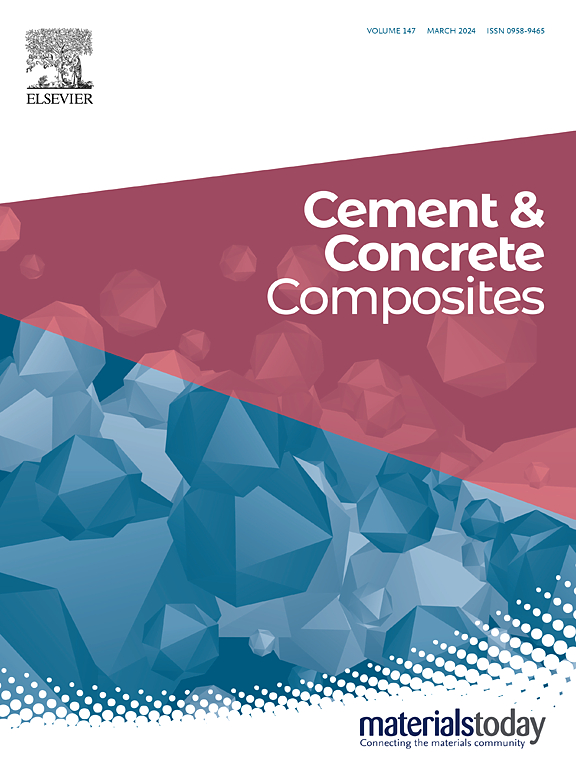混凝土养护和养护后现场监测的温度校正方案:在低碳混凝土中的应用
IF 13.1
1区 工程技术
Q1 CONSTRUCTION & BUILDING TECHNOLOGY
引用次数: 0
摘要
混凝土的长期性能主要取决于暴露和当时的气候条件,其中初始养护期的温度在决定混凝土强度发展和耐久性特性方面起着重要作用。本文介绍了电性能测量的使用,作为评估混凝土在不同现场温度条件和恒定实验室温度下相对性能的潜在测试方法。它引入了一种新的温度校正程序,以促进在标准养护期间和之后进行此类评估,以早期的工作为基础,重点关注成熟混凝土。为此,提供了含有二元和三元粘结剂的低碳混凝土混合料的测试数据,包括波特兰水泥、磨粒高炉矿渣和石灰石粉。提出归一化电阻率参数,以突出温度对一系列低碳混凝土混合料水化和微观结构发展的影响。研究表明,导电活化能具有粘结剂特异性,并且在铸造后的最初5个月内随着时间的推移而增加,其值在13-31 kJ/mol (0.14-0.32 eV/ion)之间。高水泥替代水平的混凝土表现出逐渐增加的活化能,最终达到比普通硅酸盐水泥混凝土更高的值。这表明孔隙网络更加断裂和弯曲。然而,当温度低于20℃时,这种混凝土的孔隙结构发育进程明显要慢得多。所提出的工作还表明,电气测量在技术上是直截了当的,非常适合混凝土的现场监测。本文章由计算机程序翻译,如有差异,请以英文原文为准。
Temperature correction protocol for in-situ monitoring of concrete during the curing and post-curing periods: application to low carbon concrete
The long-term performance of concrete depends primarily on the exposure and prevailing climatic conditions, with temperature during the initial curing period playing an important role in determining concrete strength development and durability characteristics. This paper presents the use of electrical property measurements as a potential testing methodology for assessing the relative performance of concrete subjected to varying field temperature conditions and constant laboratory temperatures. It introduces a new temperature correction procedure to facilitate such assessments to be conducted both during and beyond the standard curing period, building upon earlier work that focused on mature concrete. To this end, test data are presented for low-carbon concrete mixes incorporating binary and ternary binders, including Portland cement, ground granulated blast-furnace slag, and limestone powder. The parameter normalized resistivity is presented to highlight the influence of temperature on hydration and microstructural development across a range of low-carbon concrete mixes. The work presented reveals that the activation energy of electrical conduction is binder specific and increases with time during the initial five months after casting, with values ranging from 13 to 31 kJ/mol (0.14–0.32 eV/ion). Concrete with high levels of cement replacement exhibits a gradual increase in activation energy, eventually achieving higher values than plain Portland cement concrete. This indicates a more disconnected and tortuous pore network. However, when subjected to temperatures below 20oC, the progression of pore structure development in such concrete is notably much slower. The work presented also shows that electrical measurements are technically straightforward to undertake and ideally suited for in-situ monitoring of concrete.
求助全文
通过发布文献求助,成功后即可免费获取论文全文。
去求助
来源期刊

Cement & concrete composites
工程技术-材料科学:复合
CiteScore
18.70
自引率
11.40%
发文量
459
审稿时长
65 days
期刊介绍:
Cement & concrete composites focuses on advancements in cement-concrete composite technology and the production, use, and performance of cement-based construction materials. It covers a wide range of materials, including fiber-reinforced composites, polymer composites, ferrocement, and those incorporating special aggregates or waste materials. Major themes include microstructure, material properties, testing, durability, mechanics, modeling, design, fabrication, and practical applications. The journal welcomes papers on structural behavior, field studies, repair and maintenance, serviceability, and sustainability. It aims to enhance understanding, provide a platform for unconventional materials, promote low-cost energy-saving materials, and bridge the gap between materials science, engineering, and construction. Special issues on emerging topics are also published to encourage collaboration between materials scientists, engineers, designers, and fabricators.
 求助内容:
求助内容: 应助结果提醒方式:
应助结果提醒方式:


